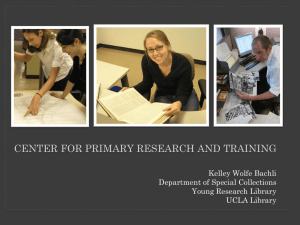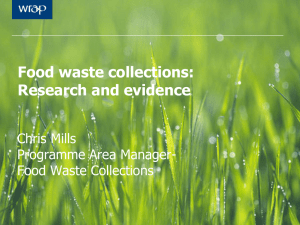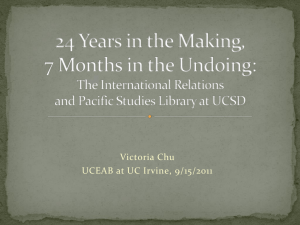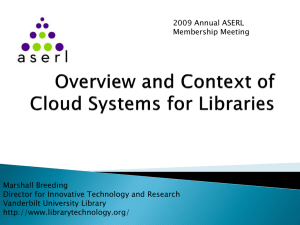2015-spring-Spec-Coll
advertisement
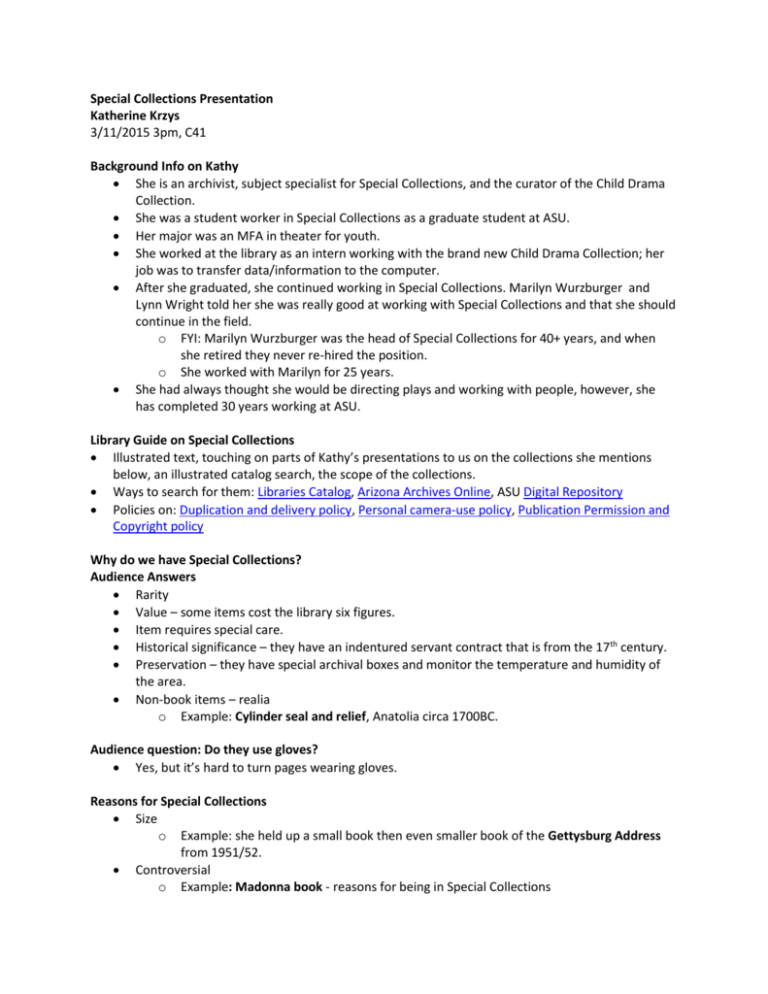
Special Collections Presentation Katherine Krzys 3/11/2015 3pm, C41 Background Info on Kathy She is an archivist, subject specialist for Special Collections, and the curator of the Child Drama Collection. She was a student worker in Special Collections as a graduate student at ASU. Her major was an MFA in theater for youth. She worked at the library as an intern working with the brand new Child Drama Collection; her job was to transfer data/information to the computer. After she graduated, she continued working in Special Collections. Marilyn Wurzburger and Lynn Wright told her she was really good at working with Special Collections and that she should continue in the field. o FYI: Marilyn Wurzburger was the head of Special Collections for 40+ years, and when she retired they never re-hired the position. o She worked with Marilyn for 25 years. She had always thought she would be directing plays and working with people, however, she has completed 30 years working at ASU. Library Guide on Special Collections Illustrated text, touching on parts of Kathy’s presentations to us on the collections she mentions below, an illustrated catalog search, the scope of the collections. Ways to search for them: Libraries Catalog, Arizona Archives Online, ASU Digital Repository Policies on: Duplication and delivery policy, Personal camera-use policy, Publication Permission and Copyright policy Why do we have Special Collections? Audience Answers Rarity Value – some items cost the library six figures. Item requires special care. Historical significance – they have an indentured servant contract that is from the 17th century. Preservation – they have special archival boxes and monitor the temperature and humidity of the area. Non-book items – realia o Example: Cylinder seal and relief, Anatolia circa 1700BC. Audience question: Do they use gloves? Yes, but it’s hard to turn pages wearing gloves. Reasons for Special Collections Size o Example: she held up a small book then even smaller book of the Gettysburg Address from 1951/52. Controversial o Example: Madonna book - reasons for being in Special Collections o Has a metal cover which requires a box People might deface the book if it was in the Hayden Stacks – controversial Example 2: Robert Mapplethorpe exhibit books in 1980s/90s People began to tear pages out of the books located in Hayden Stacks, so they were all moved to Special Collections. How to locate items in Special Collections Go to main Library website – to Catalog (avoid Library One Search) Perform a Keyword search: o All Special Collection books have SPEC as part of call number o No books have LC number, with exception of small performing ?books o Search Keyword: SPEC bible for bibles in Special Collections. Best way to search is to do Number Search using ASU LC Number. o ASU Local Call Number: SPEC o Results are ~ 32,000 items o Can Limit/Sort to arrange by title or subject . o Can Limit/Sort to arrange by oldest item or sort by year (chronologically). FYI: Special Collections stacks (and call numbers) are arranged by size o Largest books start at SPEC A – 2nd largest books SPEC B, 3rd largest books SPEC C, etc. o Smallest books are SPEC G o 2 other sets of local call numbers are used for books: SPEC PAM – for less than 60 pages and smaller than 8.5 x 11. SPEC PXL - Less than 60 pages and bigger than pamphlet size (X large pamphlet). Some items in Special Collections are not cataloged There is no record of it online but the professors know about the item. Example: Illuminated manuscript of Book of Hours, 1 page, in Latin, From France, ca. 1450 o Made of vellum; there is image of someone getting shot full of arrows (St. Sebastian) o How were they created? Books were usually created by monks; 1 person did the printed words, someone else created the borders, and someone else drew the pictures. Sometimes a person specialized in the color of inks. o Every family would have a Book of Hours. These were small books with every day prayers to read. Since only the learned knew Latin, there were images for the average person to figure out what the prayer/subject matter was about. Gutenberg Bible – 1 page, ca 1450-1455 1 leaf/page of the Gutenberg bible. Left title is at top. After it was printed, the illustrator put color in – but this process didn’t last long, so eventually books are printed in color with woodblock prints. Patten Herbal Collection of books, ca. 1480 “SPEC PAT”-Collection of books is about gardening, history of medicine, botany. Professors from various disciplines come to see these in Special Collections. Example 1: Botany Book by Fuchs from 1542 - first time cannabis appears in a book. Example 2: Botany book from collection - Maize appears for first time in a book as an illustration. Doctors or apothecaries would have these books and show their servant, who would then find and gather the plants. Example 3: Fuchs made the first pocket botanical book – a field guide. o He wrote the plant names in 5 languages – German, Latin, Greek, French, and Italian. Eugene Valentine Donation of Pop up books – “SPEC VAL” 600 pop up books of all types Examples shown: Menopause pop up book, a dinosaur pop up book with dioramas and pop up dinosaurs. Lots of Robert Sabuda books are in the collection – author of highly collectible pop up books. o She showed an example of the Wizard of Oz book by Sabuda. Science Fiction Collection of books “SPEC SF” - paperback science fiction novels “SPEC SFS” – science fiction periodicals Collection is from the golden age of science fiction from the 1940s to 1970s. Donated by a former cataloger, Mary Swaty. Some Comicon items. Showed example of a science fiction book by a local author, Alan Dean Foster. Children’s books Included are primers and pictorial books. Some are questionable stories; Example of The Whole Book, which is the story of a young boy who has a gun and shoots it and the bullet goes through a cat, etc. Examples shown of a few books. Artist’s book Collection They actively purchase for this collection; they are helped by professors. Example 1: Inside Chance book by Alberto Rios, the Poet Laureate of the State o This is a box with a poem which changes as you move the box around. o We own #23 of 100 made; but there are only 55 in existence because the artist got tired of making them. Example 2: staircase book – extends as staircase. (There are 7 repositories?) – Not sure if this relates to Manuscript Collection. Manuscript Collection Personal papers of playwrights, authors, publishers, and records of organizations. Contained in acid free boxes with folders. Descriptions are found in Finding Aids. To perform a search, go to Arizona Archives Online at http://www.azarchivesonline.org/xtf/search and perform search there, not in catalog. o There are many Finding Aids not yet digitized. Special Collections is ½ online and half still only on Finding Aids Child Drama Collection is ¼ online and the rest on Finding Aids. Example: Alan D. Foster, early draft of 1st Star Trek movie. Manuscript Collection is great resource for people wanting to be writers. o Patrons can look at the manuscripts and see the stages of writing, and communication with publishers. Star Wars Collection Was donated by Nicholas Solerno, head of Eng. Dept, was also a movie reviewer who had a TV show on channel 10 for many years. Currently processing the collection. o Some of the items have been listed as high use items by Library of Congress. Example 1: Star Wars figurines Example 2: Return of the Jedi, 3rd movie, ephemera o Item lists the movie as Revenge of the Jedi, which was the original name of the movie before it was changed. o Encapsulated? Extensive Film Collection Finding Aids are not online but in 3-ring binders There are thousands of press kits – finding aids are in shoe boxes. For silent film there are more scripts in the collection. Includes items for Harry Potter movies. Child Drama Collection Largest archive in the world for documenting preschool to high school education, adult performing for children, or children performing in theater. Lots of books on teaching drama. Plays: o Includes very simple plays. o There are adaptations of novels – for example, the Velveteen Rabbit. o Lots of serious plays on serious subjects such as the holocaust and LGBT issues. Irene Corey Collection (costume design) She designed costumes for 45 years – focusing on animals – created costumes, makeup, and set design. She is known for designing Barney. Spec. Coll. has costumes by her from Book of Job – costumes were made to look like walking stain glass, with non-reflected background fabric. o There was an example of a costume at the back of the room. To search for items, look in the ASU Digital Repository. o Search for “Irene Corey” o Results will appear for 2,846 slides representing her actors in costume and how the costumes were made. Kathy spent 12 years trying to convince Irene to donate to ASU: o Irene Corey originally wanted to give her papers to SMU in the town where she lived. o Irene and her ex-husband’s company was called Everyman Players – her ex-husband had already donated his half of the collection to ASU; eventually Irene decided the collection should not be separated.
